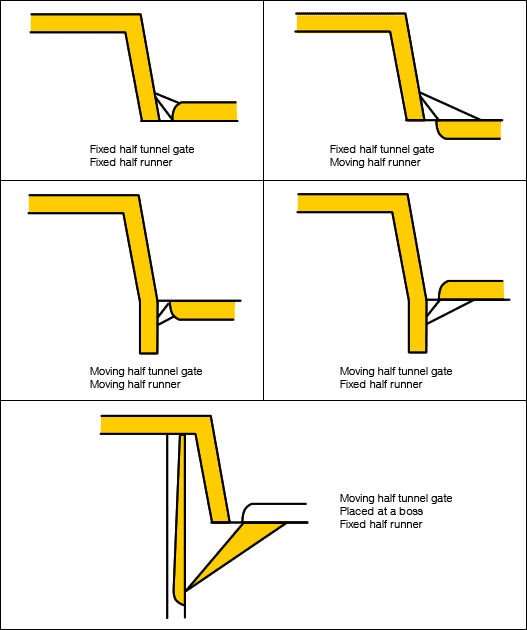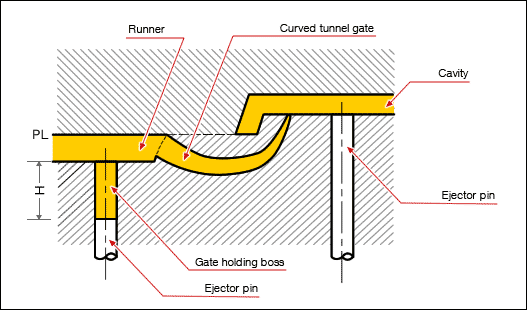#112 Varieties of Tunnel Gates
The tunnel gate (submarine gate) is used very frequently as a type of gate having a structure that automatically cuts the molded item and gate at the time of opening and closing the parting surface.
In the basic design of a tunnel gate, although know-how about the shape and size is necessary, we describe in this issue the basic varieties concerning the relationship between the molded item and the runners and gates.
The basic patterns of tunnel gates commonly used are shown in the figure.
Classifying broadly into those on the fixed half and those on the moving half of the parting surface, there are four patterns of gate and runner combinations.

When a tunnel gate is provided on the fixed half, the molded product is cut off from the gate at the time of opening the parting surface. Therefore, the condition of cutting the gate is considered to vary depending on the speed of opening the mold.
On the other hand, when a tunnel gate is provided on the fixed half, the molded product is cut off from the gate at the time that the runner ejector pin ejects the runner.
Therefore, the condition of cutting the gate is considered to vary depending on the speed of projecting the runner ejector pin.
When the runner is provided on the fixed half, since it is likely that the runner itself remains on the fixed half, a structure that pulls the runner to the fixed side such as a lock pin will be required.
When the runner is provided on the moving half, it is necessary to provide an appropriate ejector pin for ejecting the runner.
As a special example, there is also a structure in which a tunnel gate is provided on a boss shape (crafted by scraping the ejector pin) on the moving half, and the plastic is injected from the underside of the top surface of the molded product.
In actuality, the mold design is carried out by considering which gate pattern and runner pattern is appropriate based on the features of the molded product and on the properties of the plastic.
When the specifications require that traces of gate should not remain on the side surface and top surface of the molded product, it will be necessary to provide the gate on the bottom surface of the molded product.
The curved tunnel gate structure is used very rarely as a technique for such situations.

In the curved tunnel gate structure, a gate is provided that has a shape that is curved from the parting line towards the inside of the movable core. Therefore, the gate opening part is positioned at the top surface of the core.
An ejector pin is placed at the runner near the gate, and a boss is provided above that pin for supporting the gate. The overall length of the boss, denoted by H, should be selected so that, at the time of ejecting, the gate is supported until the molded product is completely removed from the mold and smooth cutting of the gate is possible.
The shape of the curved part is actually determined by trial and error while making several corrections. However, a wise measure is to use a nested division structure from the beginning so that modifications to the mold can easily be made.
Since the removal of the gate is affected by the cooling time and the pressure dwell time of the mold, at the time of prototyping it is desirable to vary even these and take samples.
Whatever method is used, the state of the cut cross-section and the cutting scrap of the tunnel gate can become a problem at the time that the molded product is cut off from the gate.
The state of the cut cross-section is affected mainly by the following factors.
- Design of the shape of the tip part of the gate
- Thickness of the gate (cross-sectional shape)
- The distance from the gate cut off part to the runner lock part
- The state of the effect of dwell pressure
- The state of polymer orientation at the gate part
- The timing of cutting off the molded product from the gate
In the case of precision molded products or multiple cavity molds, it is very important to investigate the above factors sufficiently before starting to prepare the molds.



